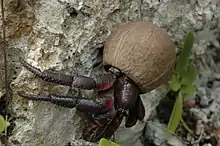Coenobita spinosus
Coenobita spinosus is one of the sixteen species of terrestrial hermit crabs.
| Coenobita spinosus | |
|---|---|
 | |
| Scientific classification | |
| Kingdom: | |
| Phylum: | |
| Subphylum: | |
| Class: | |
| Order: | |
| Infraorder: | |
| Family: | |
| Genus: | |
| Species: | C. spinosus |
| Binomial name | |
| Coenobita spinosus Milne-Edwards, 1837 | |
Range and habitat
C. spinosus can be found on Polynesian islands, Melanesia, Micronesia, the Marianne Islands and the northern coast of Australia, New Caledonia, Wallis and Futuna, and Henderson Island in the Pitcairn Islands where it has been observed to use plastic debris for protection.[1][2]
C. spinosus notably lives in forests and wetlands, but can also be found on beaches and in lagoons.[3]
Anatomy
They possess long hairy spines on their legs; although some other species have these spines, none are as long as C. spinosus.
References
- Exceptional and rapid accumulation of anthropogenic debris on one of the world’s most remote and pristine islands, Jennifer L. Lavers and Alexander L. Bond, PNAS, doi:10.1073/pnas.1619818114 approved 7 April 2017, accessed 2017-05-16
- Remote South Pacific island has highest levels of plastic rubbish in the world, Dani Cooper, ABC News Online, 2017-05-16
- "Coenobita spinosus". 22 February 2015.
This article is issued from Wikipedia. The text is licensed under Creative Commons - Attribution - Sharealike. Additional terms may apply for the media files.